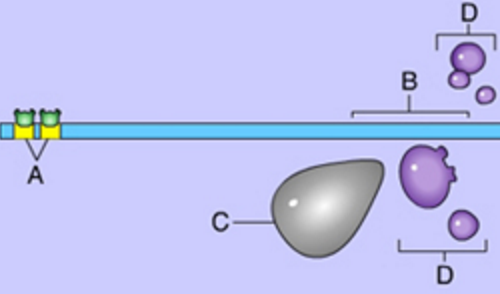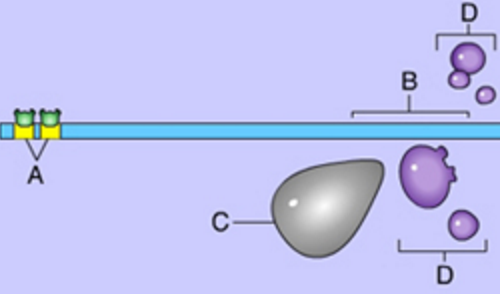The trp repressor blocks transcription of the trp operon when the repressor _____.
A. is not bound to tryptophan
B. is not bound to the operator
C. binds to tryptophan
D. binds to the inducer
C. binds to tryptophan
_____ bind(s) to DNA enhancer regions.
A. RNA
B. polymerase
C. Promoters
D. Introns
E. Activators
F. Exons
E. Activators
Activators are a type of transcription factor that bind to enhancer regions.

Which of these indicates an enhancer region?
A. A
B. B
C. C
D. D
E. C and D
A. A
This is an enhancer region.

Which of these directly bind(s) to the promoter?
A. A
B. B
C. C
D. D
E. C and D
E. C & D
Both RNA polymerase and transcription factors bind with the promoter.
DNA methylation is a mechanism used by eukaryotes to do what?
A. terminate
B. transcription
C. inactivate genes
D. facilitate the binding of DNA to intermediate filaments
E. increase the rate of transcriptioncause apoptosis
C. inactivate genes
DNA methylation, involving the attachment of methyl groups to certain bases, is a mechanism for the long-term inactivation of genes during development.
Imagine that you've isolated a yeast mutant that contains histones resistant to acetylation. What phenotype do you predict for this mutant?
A. The mutant will show low levels of gene expression.
B. The mutant will show high levels of gene expression.
C. The mutant will grow rapidly.
D. The mutant will require galactose for growth.
A. The mutant will show low levels of gene expression.
Not long ago, it was believed that a count of the number of protein-coding genes would provide a count of the number of proteins produced in any given eukaryotic species. This is incorrect, largely due to the discovery of widespread _____.
A. translational control
B. chromatin condensation control
C. alternative splicing
D. transcriptional control
C. alternative splicing
Which of the following is most likely to have a small protein called ubiquitin attached to it?
A. an mRNA produced by an egg cell that will be retained until after fertilization
B. a cyclin protein, that usually acts in G1, in a cell that is in G2
C. a cell surface protein that requires transport from the ER
D. an mRNA leaving the nucleus to be translated
B. a cyclin protein, that usually acts in G1, in a cell that is in G2
Which of these is true of the cytoplasm of an unfertilized egg?
A. It does not contain substances that are important in directing development. Development is directed solely by the surrounding cells.
B. It is a homogeneous mixture of mRNA, proteins, organelles, and other substances.
C. It is an unevenly distributed mixture of mRNA, proteins, organelles, and other substances.
D. It does not contain substances that are important in directing development. These substances are produced by the DNA of the fertilized zygote.
E. It does not contain substances that are important in directing development. These substances are supplied by the sperm.
C. It is an unevenly distributed mixture of mRNA, proteins, organelles, and other substances.
Many proteins are found concentrated at one end of the cell or another and provide positional information to the developing embryo.
How do cells become differentiated?
A. The DNA in each cell changes so that the appropriate proteins are produced.
B. Different genes are expressed so that different proteins are produced.
C. They differentiate through the process of mitosis.
D. Paternal effect genes begin the process of differentiation by providing positional information.
E. Some cells contain maternal chromosomes and some contain paternal chromosomes.
B. Different genes are expressed so that different proteins are produced.
Cell differentiation results from changes in gene expression.
The bicoid gene product is normally localized to the anterior end of the embryo. If large amounts of the product were injected into the posterior end as well, which of the following would occur?
A. The embryo would grow extra wings and legs.
B. The embryo would probably show no anterior development and die.
C. Anterior structures would form in both ends of the embryo.
D. The embryo would develop normally.
C. Anterior structures would form in both ends of the embryo.
Which of the following would be most likely to lead to cancer?
A. hyperactivity of a proto-oncogene and activation of a tumor-suppressor gene
B. amplification of a proto-oncogene and inactivation of a tumor-suppressor gene
C. failure of a proto-oncogene to produce a protein and amplification of a tumor-suppressor gene
D. failure of both a proto-oncogene and a tumor-suppressor gene to produce proteins
E. hyperactivity of both a proto-oncogene and a tumor-suppressor gene
B. amplification of a proto-oncogene and inactivation of a tumor-suppressor gene
Excess copies of the proto-oncogene could stimulate cell division abnormally, and the inactivation of a tumor-suppressor gene would eliminate a brake on cell division.
The product of the p53 gene _____.
A. allows cells to pass on mutations due to DNA damage
B. slows down the rate of DNA replication by interfering with the binding of DNA polymerase
C. causes cells to reduce expression of genes involved in DNA repair
D. inhibits the cell cycle
D. inhibits the cell cycle
Forms of the Ras protein found in tumors usually cause which of the following?
A. cell division to cease
B. DNA replication to stop
C. excessive cell division
D. cell-to-cell adhesion to be nonfunctional
C. excessive cell division
How are genes coordinately controlled in eukaryotic cells?
A. Coordinately controlled genes in eukaryotic cells are located together on the same chromosome.
B. Coordinately controlled genes in eukaryotic cells share a set of control elements.
C. Coordinately controlled genes in eukaryotic cells are activated by the same chemical signals.
B & C
In eukaryotes, specific transcription factors bind to control elements, promoting transcription of coordinately controlled genes, even if the genes are on separate chromosomes. Read about coordinately controlled genes in eukaryotes.
It is possible for a cell to make proteins that last for months; hemoglobin in red blood cells is a good example. However, many proteins are not this long-lasting; they may be degraded in days, hours, or even minutes. What is the advantage of short-lived proteins?
A. Short-lived proteins enable the cells to control their activities precisely and efficiently.
B. Long-lasting proteins are likely to make the cell cancerous.
C. Most proteins are used only once.
D. Cells lack the raw materials to make most of the proteins they need.
E. Most cells have a short life span.
A. Short-lived proteins enable the cells to control their activities precisely and efficiently.
Some proteins are needed only for short-term use.
Which of the following mechanisms is (are) used to coordinate the expression of multiple, related genes in eukaryotic cells?
A. The genes share a single common enhancer, which allows appropriate activators to turn on their transcription at the same time.
B. Environmental signals enter the cell and bind directly to promoters.
C. The genes are organized into a large operon, allowing them to be coordinately controlled as a single unit.
D. A single repressor is able to turn off several related genes.
A. The genes share a single common enhancer, which allows appropriate activators to turn on their transcription at the same time.